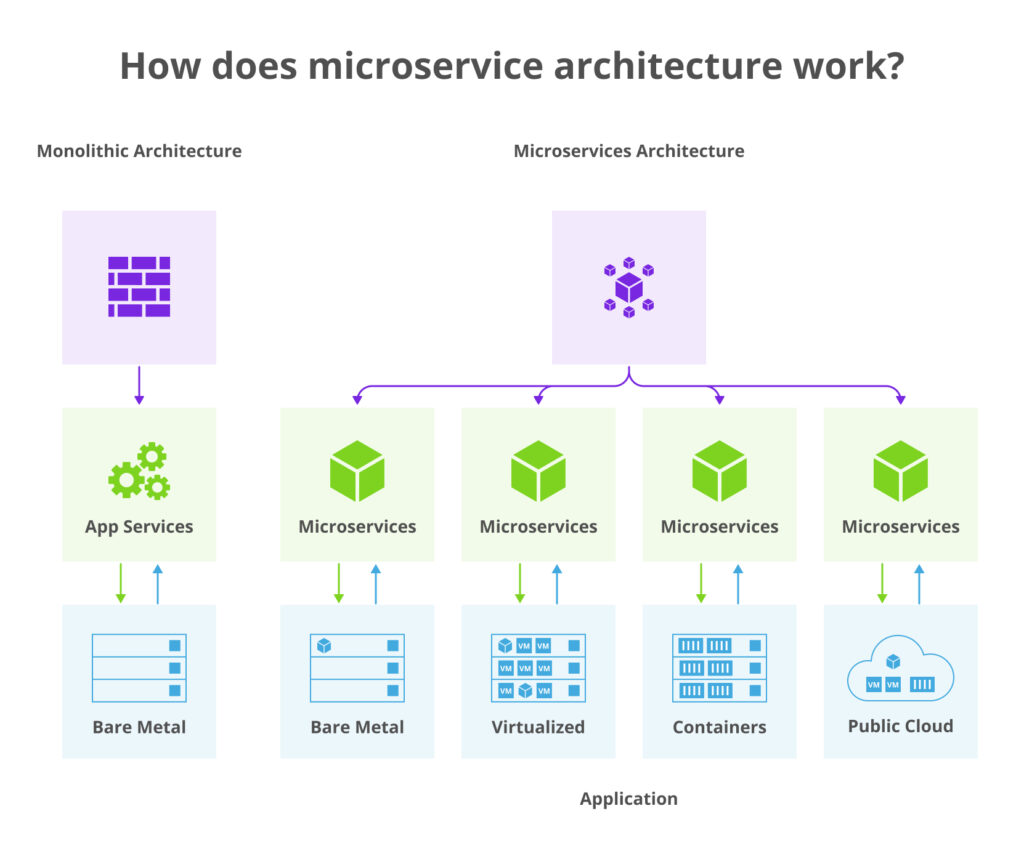Monolithic applications include several complex software modules that are strongly interconnected with each other. Therefore, even minor changes in the code affect the entire application with all the ensuing consequences. Microservices architecture, which has recently gained popularity, has elevated development to a whole new level: it has simplified bug fixing, application scaling and other operations throughout the entire lifecycle.
- What is Microservice Architecture: Definition
- Benefits of Microservice Architecture
- What is microservices architecture used for?
What is Microservice Architecture: Definition
Microservice definition follows from its name: it is a small, autonomous service with a well-defined function. The application consists of many such services – dozens, hundreds and even thousands. The process of developing an application is simplified and accelerated because microservices can be developed and maintained independently of each other.
Other features of microservices worth highlighting specifically:
- perform a specific task and use their own logic;
- are deployed and rebuilt separately without affecting other microservices;
- interact with each other through simple interfaces (APIs);
- can be created using different technology stacks and libraries;
- a single development team often writes code for each microservice.
What is the difference between monolithic and microservice architecture? Monolithic architecture often becomes an obstacle to rapidly developing and testing new features, making modifications, and delivering applications to end users. This architecture is often called “heavy” and “cumbersome”: the fact that some modules are strongly interconnected and complex makes all the above processes more time-consuming and require more human resources. Moreover, microservice architecture differs from monolithic architecture because it is easier to deploy, debug and apply and is more preferable regarding the rate of introducing innovations and bringing new projects to market.
The difference between monolithic applications and applications based on microservice architecture is clearly shown in the image below:

Users do not care at all whether application architecture is monolithic or microservice. The interface and functionality of the applications will be identical.
Microservices-based applications use containerisation technology (or just “containers”) for deployment. Kubernetes is one of the most popular platforms for running and managing containers. We dedicated a separate article to it.
Colobridge’s Expert:
“Often people start thinking about switching to a microservice architecture when a monolithic application is constantly scaling and becoming more complex, when dozens of engineers are already working on it, but their productivity decreases and releases are delayed. However, one should be prepared that after “migration” from monolith to microservices, there still can be quite a lot of microservices – for example, ranging from 1000 for large online projects and as many or more databases. Perhaps the same experts will continue working on the project, but their performance and overall development speed will improve, and bug fixes and updates will take less time”.
Benefits of Microservice Architecture
Microservice architecture has several advantages over monolithic architecture:
- Flexibility. Changes made to one microservice do not impact other microservices, simplifying updating applications and speeding up development.
- Cross-platform software. Microservices for the same application are written in different programming languages without being tied to a single technology stack. This makes it possible to create applications that work equally well in different environments.
- Security. With microservice architecture, controlling all dependencies that arise when launching applications and managing access to individual services is easier.
- Stability. Errors made while developing one microservice will only affect its performance and will not affect other microservices (protection against cascading failures).
What is microservices architecture used for?
Microservice architecture is perfect for implementing projects that require flexibility and scalability in development, frequently adding new features or making releases. Content delivery systems (CDN) are examples of such projects. In such projects, the application can be roughly divided into several microservices, which are responsible for the following operations:
- storing information about user accounts;
- storing and providing information about the content available;
- processing orders placed in the Shopping Cart;
- processing payments for the content purchased on the website;
- delivering content to the user.
To get advice on deploying microservices in cloud or scenarios for placing monolithic applications, contact Colobridge experts. We will offer the best possible options for implementing your IT infrastructure, particularly for developing and testing applications.





